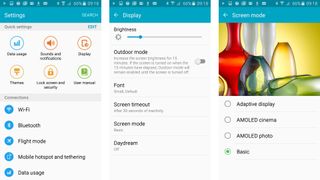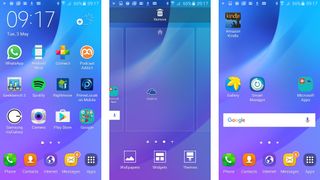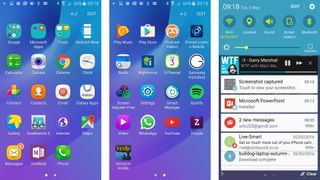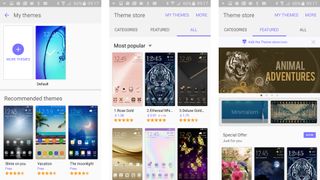Why you can trust TechRadar
Display
- 5-inch, 1280 x 720 Super AMOLED screen
- No ambient light sensor or auto brightness makes for frustrating use
There are some rather frustrating omissions that tone down the appeal of this efficient mimicry, though. The single most annoying thing about the Samsung Galaxy J3, the part that almost single-handedly would stop me recommending this phone to budget-conscious friends, is the screen backlight.
There's no ambient light sensor, and no auto brightness mode, so you have to turn the screen level up and down every time you head outside or return home.
At one point I went into a cinema with the handset, and even switching it on before the trailers started was enough to fill me with embarrassment of the acuteness experienced by two Englishmen stuck shoulder-to-shoulder in a lift door.
Manual brightness-setting is a daily pain in the backside. However, props to Samsung inasmuch as, as usual, its display is super-super bright.
And in place of where an auto mode might be there's an outdoors button that turbo-charges the screen, giving it enough backlight power to compete with the brightest of conditions.

The Galaxy J3 has a 5-inch, 1280 x 720-pixel Super AMOLED screen. Samsung is the only big brand that can afford to squeeze a display of this type into such an affordable phone – it's the master of phone OLEDs.
OLEDs destroy LCD screens in terms of contrast and black level – and in this case brightness too, compared to entry-level 720p LCDs.
However, I actually prefer the character of LCD screens. It's all down to one little word: PenTile.

This is a Samsung screen architecture designed to address the problem of OLED sub-pixels deteriorating at different rates. Here the pixels share sub-pixels, which leads to a certain fizziness in the screen. The Galaxy J3 looks less sharp than a 5-inch 720p LCD phone would, and it's something I noticed instantly after turning the phone on. Hello PenTile my old friend.
That said, within a couple of days my eyes had bedded into that PenTile fizz. I just stopped noticing it –and part of my job is being a screen snob.

As with other OLEDs, the Samsung Galaxy J3 has super-saturated colors, but you can tame them to an extent using the phone's four screen modes. Just like on the higher-end Samsungs, you can pick between Adaptive Display, AMOLED Cinema, AMOLED Photo and Basic in the Settings menu.
They're not as good as the calibrations in the Galaxy S7, of course. The first three are quite severely oversaturated, and even Basic doesn't have the chilled-out, natural shades you'll see in the more expensive Samsung phones and tablets; reds still run ever-so-slightly hot.
However, I'm pretty happy with the phone in Basic mode. It gives you much richer colors than most budget handsets, which will often only hit 70-odd percent of the sRGB color gamut.
Parts of the Galaxy J3 screen are admirable, then, but it's hard to forgive the lack of auto brightness. The top screen layer is not Gorilla Glass either; it's clearly toughened, but there's a risk that it may pick up scratches a little more quickly, and it isn't as fingerprint-resistant as some more expensive mobiles.
Key features
The Samsung Galaxy J3 has a pretty limited core feature set. There's just 8GB of storage in the base model, for example, when the best phones at this £150 (US$200, AU$260)-ish price now tend to have 16GB.
As there's a microSD slot it's not a killer issue, but it's enough to stop me marveling at the price.
Right now in the UK, for example, you can get the 8GB Moto G (2015) for £129 ($179.99, around AU$250), a good £20 cheaper; and while 16GB and dual-SIM versions of the J3 are available in some regions, they just push the price up even higher.
If you wanted the newer Moto G4 it'll cost £169 ($199, around AU$330) for the lowest storage version, but that's not much more than the Galaxy J3.
The phone does have 4G and even NFC, a Samsung favorite, but it doesn't have a fingerprint scanner or support for ac-grade Wi-Fi. So it's patchy in terms of features; I'd much rather have an auto brightness setting than NFC, as it's far more useful day-to-day, but presumably Samsung's investments in wireless payments mean NFC is a 'must-have' in all but its cheapest phones.

One feature Android veterans will notice, others maybe not, is that the Galaxy J3 runs Android 5.1.1, rather than Android 6 - and there's no sign of the latest Android 7 Nougat update.
It's an odd and outdated feature, but ultimately it doesn't make a huge difference because the J3 has the TouchWiz interface, which alters the look and feel of every part of the software.
It's a slightly older version of TouchWiz than that found on the Samsung Galaxy S7, but overall it looks and feels very similar. TouchWiz is a pretty good UI these days, no longer overburdened with superfluous features; it's not quite as pretty as vanilla Android, but it's no pig, is it?

One feature app hoarders may appreciate is the option to create app folders within the apps menu, and rearrange their order.
TouchWiz supports themes too, enabling you to easily reskin the Galaxy J3 with new icons, wallpaper and fonts without doing any real work. Many cost money at this point, but plenty are available for free.

It's a good interface for a budget phone, although with only 8GB of storage in the base model the fact that so much space is taken up by preinstalled Microsoft Office apps annoys. Within a few days I'd filled the phone up, and that was without any heavy-duty game installs.
Another hit to the J3's gaming cred is the speaker positioning. It's on the back, with just a single driver unit. Top volume is fairly good, but it predictably sounds a lot thinner than Samsung's high-end phones at maximum volume.
Current page: Display and key features
Prev Page Introduction and design Next Page Performance and battery lifeAndrew is a freelance journalist and has been writing and editing for some of the UK's top tech and lifestyle publications including TrustedReviews, Stuff, T3, TechRadar, Lifehacker and others.


